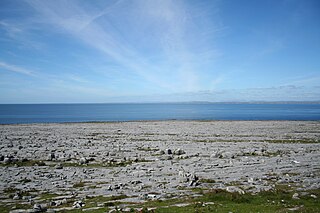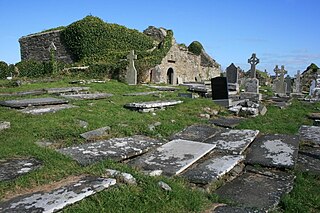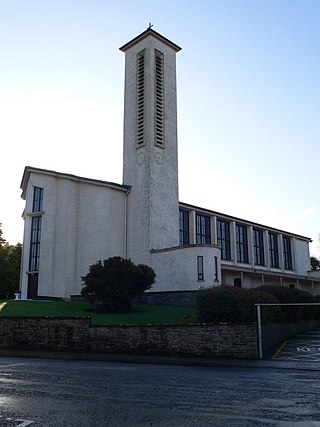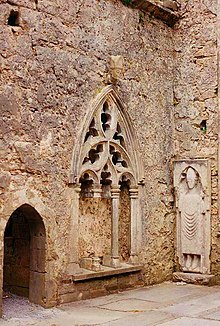
The Burren is a karst/glaciokarst landscape centred in County Clare, on the west coast of Ireland. It measures around 530 square kilometres (200 sq mi), within the circle made by the villages of Lisdoonvarna, Corofin, Gort and Kinvara. The area includes such natural features as Mullaghmore hill and Ailladie cliffs, and historic monuments such as Poulnabrone dolmen and Caherconnell Stone Fort. The Burren National Park covers a small part of the Burren and is the smallest of the six National Parks in Ireland, while the adjacent territory, including the Cliffs of Moher, is included in the Burren and Cliffs of Moher Geopark.

Kilfenora is a village and a civil parish in County Clare, Ireland. It is situated south of the karst limestone region known as the Burren. Since medieval times when it was the episcopal see of the Bishop of Kilfenora, it has been known as the "City of the Crosses" for its seven high crosses. The village had around 220 inhabitants in 2011. Much of the TV show Father Ted (1995–98) was filmed there.

Kilmacduagh Monastery is a ruined abbey near the town of Gort in County Galway, Ireland. It was the birthplace of the Diocese of Kilmacduagh. It was reportedly founded by Saint Colman, son of Duagh in the 7th century, on land given him by his cousin King Guaire Aidne mac Colmáin of Connacht.

Clonfert Cathedral is a cathedral of the Church of Ireland in Clonfert, County Galway in Ireland. It is in the ecclesiastical province of Dublin. Previously the cathedral of the Diocese of Clonfert and then one of three cathedrals in the United Dioceses of Limerick and Killaloe, it is now one of five cathedrals in the Diocese of Tuam, Limerick and Killaloe.

Kilshanny is a village and a civil parish in County Clare, Ireland.

Corcomroe Abbey is an early 13th-century Cistercian monastery located in the north of the Burren region of County Clare, Ireland, a few miles east of the village of Ballyvaughan in the Barony of Burren. It was once known as "St. Mary of the Fertile Rock", a reference to the Burren's fertile soil.

The Diocese of Galway, Kilmacduagh and Kilfenora is a Latin Church diocese of the Catholic Church in the west of Ireland. It is in the ecclesiastical province of Tuam and is subject to the Metropolitan Archdiocese of Tuam. The deanery of Kilfenora, previously a diocese in its own right, lies in the ecclesiastical province of Cashel. The ordinary is Bishop Michael Duignan who was appointed on 11 February 2022.

The Diocese of Limerick and Killaloe was a former diocese of the Church of Ireland that was located in mid-western Ireland. The diocese was formed by a merger of neighbouring dioceses in 1976, before itself merging with the neighbouring Diocese of Tuam in 2022 to form the Diocese of Tuam, Limerick and Killaloe.

Brendan Kelly is an Irish former Roman Catholic prelate who served as Bishop of Galway and Kilmacduagh and Apostolic Administrator of Kilfenora between 2018 and 2022.
The Bishop of Kilfenora was a separate episcopal title which took its name after the village of Kilfenora in County Clare in the Republic of Ireland. In both the Church of Ireland and the Roman Catholic Church, the title is now united with other bishoprics.

St Mary's Cathedral is a cathedral church of the Diocese of Tuam, Limerick and Killaloe in the Church of Ireland. It is located in Tuam, County Galway, in Ireland. From the 12th century until 1839, both before and after the Reformation, it was the seat of the former Archdiocese of Tuam. Most of the present structure dates from the 1870s, but parts of earlier 12th- and 14th-century structures survive within.

The Cathedral Church of St Flannan, Killaloe is a cathedral of the Church of Ireland in Killaloe, County Clare in Ireland.
The Bishop and Apostolic Administrator of Kilmacduagh and Kilfenora was an episcopal title which took its name after the small villages of Kilmacduagh in County Galway and Kilfenora in County Clare, Ireland. Accurately, the title was an alternative sequence of the Bishop of Kilmacduagh and Administrator Apostolic of Kilfenora followed by the next holder as the Bishop of Kilfenora and Administrator Apostolic of Kilmacduagh.

Kilmacrehy, sometimes also Kilmacreehy, is a civil parish in County Clare, Ireland. The ruins of the old parish church lie near the coastal village of Liscannor, which is also a part of the parish.

Killilagh or Killeilagh is a civil parish in County Clare, Ireland. It contains the village of Doolin.
Kiltoraght is a civil parish in County Clare, Ireland. It is just south of Kilfenora and is part of Catholic parish of Kilfenora.

Kilmanaheen is a civil parish in County Clare, Ireland. It contains the market town of Ennistymon.

The Diocese of Tuam, Limerick and Killaloe is a diocese of the Church of Ireland that is located in the west of Ireland. The diocese was formed by a merger of the former Diocese of Tuam, Killala and Achonry and the former Diocese of Limerick and Killaloe in 2022, after the retirement of the separate dioceses' bishops and the appointment of Michael Burrows as bishop of the united diocese. It is in the ecclesiastical province of Dublin. It is one of the eleven Church of Ireland dioceses that cover the whole of Ireland. The largest diocese by area in the Church of Ireland, it covers all of counties Clare, Galway, Kerry, Limerick and Mayo, plus parts of counties Cork, Sligo, Roscommon, Offaly, Laois and Tipperary.


















